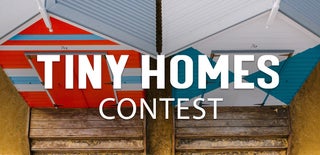Introduction: Introduction: Ecologic Tiny Home Inspired by Nature
I am Kristan Otten. I live in The Netherlands, Almere. I am 12 years old.
I chose this instructable, because I saw the picture at the frontpage and I like to build houses.
In the next coming years it is cheaper and handier to be self-sufficient. That is why I designed this Tiny Home, you can produce your own food and your own electricity.
Step 1: Step 1: Inspiration
First I searched on the web how some animals live. I found a beehouse and an antsnest. I made a design for both, to see what inspired me the most. It was the antsnest, because ants are masters in recycling and climate control.
I designed the nest in a very simple and basic way. I made it with Tinkercad because I worked a few times before with this program at school.
After making the basic design in Tinkercad, I had to think about the interior. Because it had to be a Tiny House, the inside is simple: just what is needed most.
On our bookshelf I found a book with the measurements of humans and furniture, so I could draw it on paper in the right scale.
Step 2: Step 2: Research
I choose to work in Tinkercad, because that was the only draftingprogram I had, and because I know how to work with it.
I was experimenting what kind of shapes to use. I decided only to use basic shapes in different modules and edited them to the right lenght. I chose the modules, because they are easy to produce and the customers can choose how many they want. And they can be easily transported to the right place. And easy = cheaper!
I thought it would be very handy to be self-sufficient. I visited some tiny houses near by the city I live in (Almere) and I saw solar panels on handy positions. So that is what I used in my design.
Step 3: Step 3: How Big?
This photo shows how I checked the maximum demanded 90 m2 for the Tiny Home.
First I looked at the m2 of each different shape. I used my calculator and my mind to calculate the total amount of m2's.
I love math so this was easy to do.
Step 4: Step 4: Drawing
I found some a4 size papers to draw my design on.
First I used a pencil, an eraser, a calliper and a ruler. Sometimes I was looking for the perfect shapes, but I learned to never give up. When I was looking for the right interior, I searched on the web for some kitchens and livingrooms for inspiration.
Step 5: Step 5: Scale
This photo shows how to determine the right scale for a book.
I first made some sketches and then I drew them on a 1:20 scale. I used a ruler with diffrent scales on it to draw the right scale.
It was difficult to search the right scale for a4 size paper. After some attempts I succeeded.
Step 6: Step 6: Dimensions
I read a book about human sizes. For example: chairs and tables and how to draw them. I used that in my interior drawing for every module of my house. It is a bit difficult to draw them, so I practiced a lot.
Step 7: Step 7: Finishing Touch
The last step was making my drawings look nice by making my lines more clearly with a felt tip pen.
I used a colouring pencil for the furniture in my tiny house. For a better understanding, I gave every kind of furniture its own colour.
I enjoyed making this design and instructable.
I hope I have inspired you to try it too.

Participated in the
Tiny Home Contest







